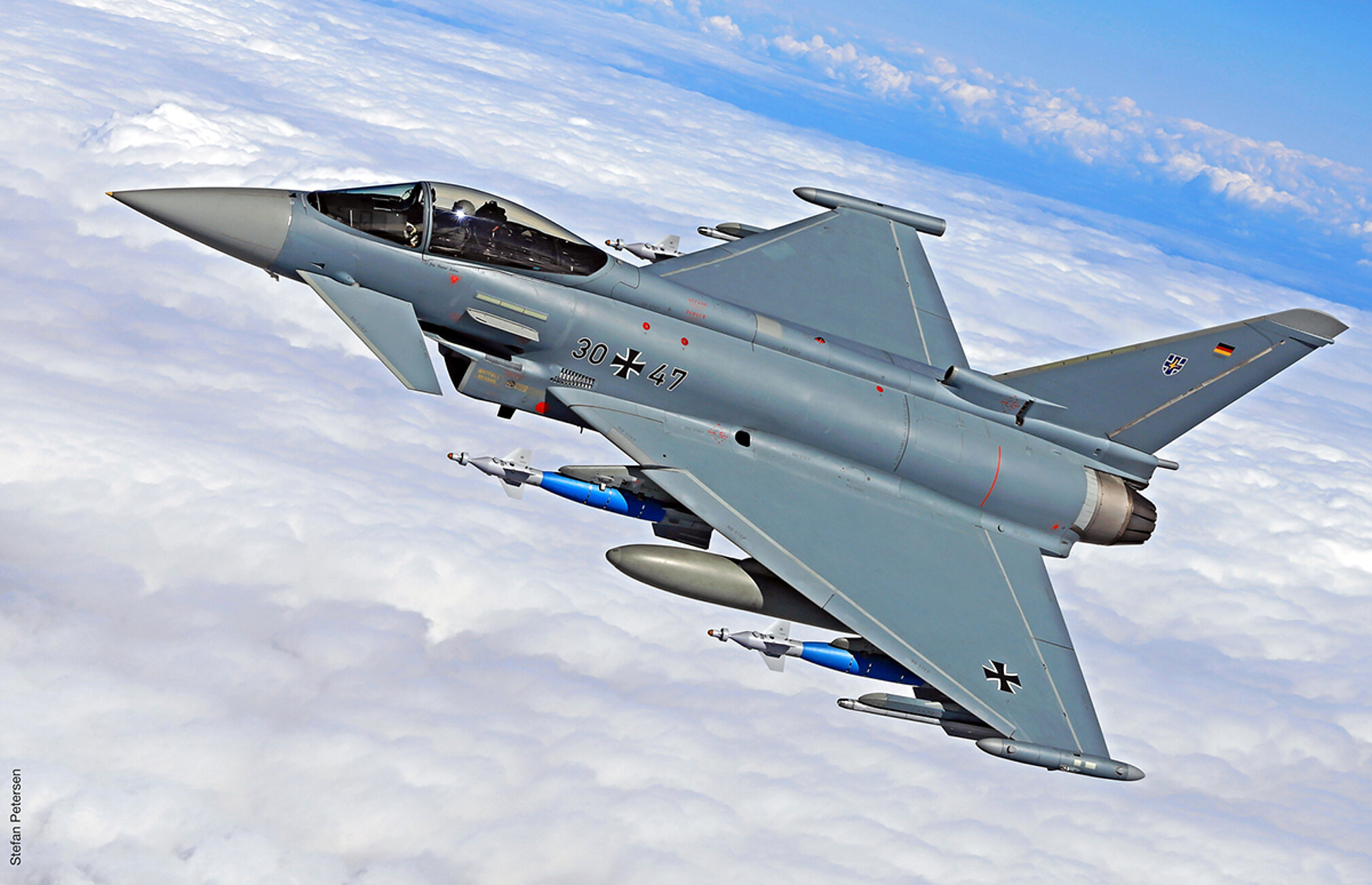Future-proofing the Eurofighter Typhoon
Technological radar leap
Active Electronically Scanned Array (AESA, or E-scan) radars are an essential feature for the modern fighter aircraft such as the Eurofighter Typhoon. This advanced capability has been under development by HENSOLDT and its partners for some time now and has recently resulted in the first E-scan radars being delivered for Typhoon export orders for Kuwait and Qatar.
Januar 21, 2022
info@hensoldt.net
CATEGORIES:
Innovation
Radar
In a nutshell: Aiming for a new Eurofighter radar
Now, sensor specialist HENSOLDT is under contract to supply AESA radars for the 38 Eurofighter Typhoon Tranche 4 aircraft on order for Germany’s Luftwaffe under Project name Quadriga, plus a large-scale retrofit programme for earlier aircraft from Tranche 2 and 3.
Furthermore, for the first time the company is leading the development of a new radar. To be implemented in the middle of the decade, the new radar answers new operational requirements by adding considerable capability to the first iteration of Typhoon E-scan radar.
ECRS MK1 development
HENSOLDT and its partners in the cross-industry EuroRADAR consortium – Leonardo in the UK and in Italy, Indra in Spain – collectively developed the first AESA radar for the Typhoon. This resulted in what is known today as CAPTOR-E, Radar 1+, or just Mk0, and has been selected for the Typhoons ordered by Kuwait and Qatar.
HENSOLDT supplies antennas and other components into this programme and will continue to do so with any further Mk0 sales and follow-on orders. At the same time, the company continues to support the Typhoon’s original mechanically scanned CAPTOR-M radar.
For the new-build Quadriga aircraft and upgrades of the existing fleet, HENSOLDT will develop and produce the ECRS (Eurofighter Common Radar System) Mk1 radar. Full development of this sensor system was already initiated in June 2020 by the company and its Spanish partner Indra following German parliamentary approval.
While utilizing “legacy” Mk0 components, the Mk1 introduces a new digital multi-channel receiver and transmit-receive modules (TRM) with significantly enhanced bandwidth. These enhanced capabilities enable the implementation of new features such as electronic attack, improved target recognition, and ultra-high-resolution synthetic aperture radar (UHR-SAR) imaging.
Significant order, big potential
HENSOLDT has 150 Mk1 on order to cover the Quadriga aircraft and the existing Luftwaffe fleet retrofit, the latter covering Tranche 2 and 3 aircraft.
ECRS Mk1 radars will initially be installed in a so-called “Step 1” configuration that significantly expands on the existing capabilities of the MK0, but the HENSOLDT/Indra team is already planning for the “Step 2” iteration. This is essentially a major software upgrade that will further exploit the processing capabilities inherent in the system, adding task-based management, electronic warfare as well as other advanced features. The high pace of development in the field of electronics and, above all, digitalisation constantly gives rise to new applications.
Thus, the Eurofighter will benefit in the future from a primary sensor that is technologically top class and will improve the aircraft’s survivability even in high-intensity conflicts.
Dr Torben Brack
Head of Sales Eurofighter Radar
The already sizeable requirement for Mk1 radars is expected to grow. Spain has a requirement for 20 new MK1-equipped Eurofighter Typhoons to replace its EF-18 Hornets under its “Halcon” project and could also retrofit some of its existing Typhoon Tranche 2/3 aircraft. Germany is also expected to acquire another batch of new Eurofighter Typhoons in Tranche 5 as part of its Tornado replacement programme later this decade.
For HENSOLDT this multitude and increasing volume of E-Scan radar business means a significant ramp-up in its personnel and production capacity. As an example, more than 250,000 transmit/receive modules (TRM) for the Mk1 antennas will be required over the next decade, with all these modules being produced at the company’s highly specialized Microwave Factory in Ulm, Germany.
EuroRADAR lead and partner Leonardo will continue to supply some elements of the Mk1 radar as part of the ECRS framework, in the same way that HENSOLDT will provide components into the Mk0 and possibly the Leonardo-led Mk2 radar being developed for the UK and Italy.

Future Combat Air System
The Eurofighter Typhoon is expected to serve until at least 2060 and, as such, will undergo further capability enhancements, especially as it will be expected to operate as part of the Future Combat Air System (FCAS) that is currently under development by France, Germany, and Spain.
Equipped with the new Mk1 radar—particularly in its “Step 2” variant—the Typhoon will be an ideal ‘legacy’ partner to the Next Generation Fighter, able to participate in complex operations utilizing the Air Combat Cloud as well as Remote Carrier capabilities. The radar also forms an integral element of the Typhoon’s development roadmap, the Long-Term Evolution (LTE) programme, which sets out to ensure that the aircraft remains a viable combat platform over the coming decades.
With the ECRS Mk0 now being delivered, and the Mk1 on order and multi-channel receiver units now in build, the road to equipping the Eurofighter Typhoon with an AESA radar has finally become a reality.
HENSOLDT has been at the heart of that development process and is now leading the way in bringing the game changing AESA technology to the front line.